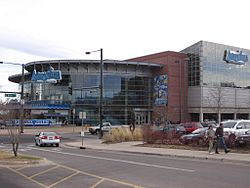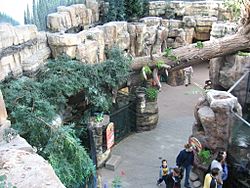Downtown Aquarium, Denver facts for kids
 |
|

Exterior view from the parking lot
|
|
| Date opened | June 21, 1999 |
|---|---|
| Location | Denver, Colorado, U.S. |
| Land area | 17-acre (6.9 ha) |
| Coordinates | 39°45′6″N 105°0′51″W / 39.75167°N 105.01417°W |
| No. of animals | 5,000 |
| No. of species | 500 |
| Total volume of tanks | 1,000,000 US gallons (3,785,000 L) |
| Memberships | AZA |
The Downtown Aquarium in Denver, Colorado, is an exciting place to discover amazing aquatic animals! It used to be called Colorado's Ocean Journey. This special building is a public aquarium and also has a restaurant.
You can find it in Denver, Colorado, right where I-25 and 23rd Avenue meet. The main building is about 107,000 square feet and sits on a 17-acre area next to the South Platte River.
Inside, the aquarium has huge tanks filled with about 1 million gallons of water. These tanks hold both freshwater and saltwater animals. You can see a wide variety of fish and other creatures here.
The Downtown Aquarium in Denver is owned and run by Landry's Restaurants, Inc.. It is also officially recognized by the Association of Zoos and Aquariums (AZA). This means it meets high standards for animal care and education.
History of the Downtown Aquarium
How the Aquarium Started
The aquarium first opened its doors on June 21, 1999. It was originally called Colorado's Ocean Journey. Two people, Bill Fleming and Judy Petersen Fleming, started it as a nonprofit group.
Building the aquarium cost a lot of money, about $93 million. Some of this money came from a large loan. Soon after opening, it earned its accreditation from the Association of Zoos and Aquariums (AZA).
Changes and New Ownership
For a few years, many people visited the aquarium. However, after the events of 2001, fewer visitors came. The aquarium faced financial challenges because of this.
In March 2003, a company called Landry's Restaurants, Inc. bought the aquarium. They paid $13.6 million for it.
Renovations and Renaming
The aquarium stayed open until the summer of 2005. Then, it closed for a short time for some big updates. During this time, they added a full restaurant, a bar, and a large room for events.
A huge new marine aquarium, holding 150,000 gallons of water, was added to the restaurant area. On July 14, 2005, the facility reopened with a new name: the Downtown Aquarium.
Exploring the Exhibits

Rivers to the Ocean Theme
A main idea for this aquarium, which is far from the ocean, is how freshwater ecosystems connect to the ocean. The aquarium was first designed to show the journey of two rivers to the sea.
One journey followed the Colorado River in North America. The other followed the Kampar River in Indonesia.
The Colorado River Journey
This part of the aquarium showed animals from the Colorado River. You could see endangered fish like desert pupfish. There were also gamefish such as bass.
You could also spot northern river otters playing. This journey ended with a large exhibit showing the Sea of Cortez (Gulf of California). This is where the real Colorado River flows into the ocean.
The Indonesia River Journey
The Indonesia River Journey featured animals from that region. Visitors could see unique fish like Asian arowanas and rainbowfish.
It also had exhibits for amazing animals like endangered Sumatran tigers. This journey finished with a big exhibit representing the southern Pacific Ocean.
New Exhibit Layout
After the renovations in 2005, the two river paths are still there. However, the animals are not strictly grouped by their original river anymore. For example, some tanks now show animals from African and South American freshwater places. Other tanks have a mix of different species living together.
Interactive Fun
The aquarium has several fun hands-on exhibits. You can gently touch horseshoe crabs in a special tank. There is also a stingray tank where you can touch and even feed the stingrays!
Protecting Animals
The Downtown Aquarium cares a lot about conservation. They work to protect animals. They have many endangered or threatened species.
This includes 12 types of fish, six types of reptiles, two types of mammals, and two types of birds. The aquarium also helps with the AZA's Species Survival Plan. This plan helps protect animals like the Sumatran tigers.
Learning and Education
Deep Blue Sea Foundation
The aquarium has a special volunteer program. This program is run by a nonprofit group called the Deep Blue Sea Foundation. This foundation was created to make sure the aquarium continues to teach people about marine life.
Educational Programs
The aquarium also offers educational classes and workshops. These programs help visitors learn even more about the amazing animals and ecosystems found in the aquarium.
See also
 In Spanish: Acuario del Downtown para niños
In Spanish: Acuario del Downtown para niños

